

The Vox Bassmaster bass was a short scale (30"), two-pickup bass, with very simple controls: one volume and one tone. White plastic controls, typical of most JMI Vox guitars of this period. This one has a laminate wood body, sycamore neck and rosewood fretboard with dot inlays. Early Vox literature describes the Vox Bassmaster body as 'lightweight hardwood', and for some basses (see this 1965 Vox Bassmaster) Vox used mahogany, although there are examples using other one-piece wood bodies, maybe sycamore, and potentially agba.
It is a light bass, weighing in at just 3kg, and with it's short scale and simple components perfect for the entry level bass players of the early 1960s. The Bassmaster was advertised from late 1960, and available right through to 1967, when Vox guitar production ceased in the UK. The bolt-on neck is very thin; nut width is just 1 5/16", and was supplied by a local British furniture manufacturer, G-plan. The light weight and easy dimensions, made for an effective easy playing instrument, perfect for the student musician. Although a truss rod was fitted it was not adjustable.
The Sunburst finish on this bass is quite unusual, especially for an early lower end bass. Red is by far the most commonly seen colour, and along with white the only finish listed in Vox literature (for example the 1964 Precision in Sound). Compare this three-colour sunburst with a darker two-colour burst of a 1965 Bassmaster.
Note the jack plug is side-mounted, another early feature. A year or so later they were positioned on the front, next to the tone control. This would originally have been a coaxial input, but like most Vox's this has been swapped for a standard guitar jack.
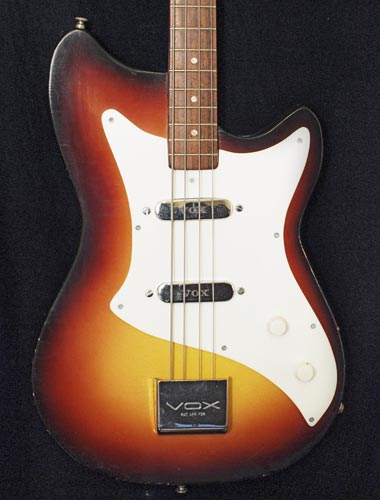


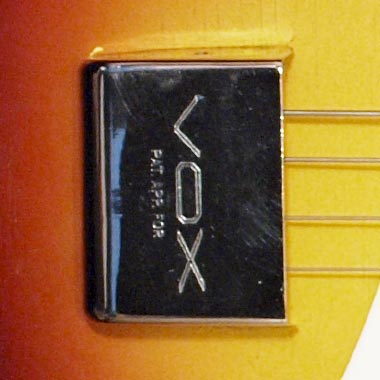
Most early UK-produced (Dartford) Vox guitars had the green scripted Vox logo shown here; a purely British feature, not seen on any of the Italian Vox models. The decal also has the model name - later versions often had the Vox logo on a separate transfer, situated at the far end of the headstock. These JMI Vox decals are not very durable at all; it is rare to find one in undamaged condition.
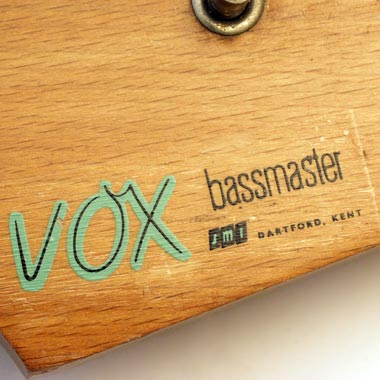

The laminate body of this bass is visible in the unfinished neck pocket, and (less obviously) on the body edge. Some middle period Vox's (generally the later British built ones) had dates, or other markings stamped in the neck pocket, although not in this case. Laminate wood construction was a standard feature of most early sixties solid body Vox guitars, but by 1964/65 pretty much all guitars leaving the Vox factory had a one-piece agba or mahogany body.
Another feature obvious in this picture is the single-ply white pickguard. Later Vox Bassmasters have the three-ply white/black/white traffolyte guard (see this 1965 Vox Bassmaster for comparison).
This image shows two Bassmaster bodies - top: this 1963 Bassmaster with plywood body, bottom: a 1965 Bassmaster with solid mahogany body. Note the difference in curvatures between the two edges. This rounded profile was just one example of how UK Vox guitars improved as the decade progressed.
Another difference between these two basses are the different scratchplates; the 1963 Bassmaster has a thinner single ply white plate, but the '65 has the thicker three-ply, white-black-white guard with wide black revealed edge. The later versions of this guitar, and many other UK Vox guitars are almost always the superior quality instruments.
The Bassmaster bass is less Fender-like than other early Vox guitars (most notably the Symphonic bass), but neither is it particularly original, at least compared to the Phantom and Mark basses also under production in the mid 1960s.
Subscribe to the vintageguitarandbass youtube channel for more vintage guitar and bass demos. Also, check out the other Vox Bassmaster videos in the supporting members area.
Find out more about these instruments here: 1963 Vox Bassmaster, 1963 WEM ER-15
A UK-built (JMI) 1963 Vox Bassmaster dual pickup bass guitar, played through an (also 1963) British WEM ER-15 head with Pick-A-Bass cab. I usually prefer flatwounds on basses like this, but the ancient rattley roundwounds that were on it just sounded so great cranked up, I had to record it. Check it out - listen to the end!
Recorded here with an Electrovoice RE-20 (left channel) and a Shure SM57 (right channel), through a Focusrite Scarlett 2i2 interface - highly recommended gear!
Find out more about these instruments here: 1963 Vox Bassmaster, 1973 WEM Dominator Bass Mk 1
The WEM Dominator bass amp is a British 15w tube amp with a 15" Celestion G15M speaker. And it gets plenty dirty! Always my first choice for some snarly overdriven bass. The Vox Bassmaster is a cool little guitar, and as can be heard here quite capable of laying down some tones! It's very, very, playable, the Vox V1 pickups are pretty sweet, and the combination of short scale and thin neck make this one of the easiest playing basses ever made!
Recorded here with an Electrovoice RE-20 (left channel) and a Shure SM57 (right channel), through a Focusrite Scarlett 2i2 interface - highly recommended gear!
Find out more about these instruments here: 1963 Vox Bassmaster, 1964 Ampeg B-15N
For snarly distortion, I love my WEM amplifiers, but for cleaner tones, nothing beats an Ampeg B15. Unlike the previous videos (above), the bass is now strung with flatwound strings (shortscale, Rotosound Jazz Bass RS77S, 40-90, so still fairly light). These are not actually ideal, as the ball-end silk windings actually extend over the saddle - not great for accurate intonation, but it's the set I bought! (Labella Deep Talkin' strings don't have winding at this end, but I didn't have any spare on the day I was making the video). It's a nice sounding bass, although with somewhat limited controls: despite the dual pickups, it only has a master volume and master tone - no option to select the pickups individually. The neck is narrow, but not too shallow, and topped with a nice radiused rosewood fretboard. Some other early Vox instruments had a flat sycamore board - notably the Clubman bass. Actually rather good for playing some of those faster runs not so easy on some necks. The Vox V1 pickups are (as always) pretty nice - plenty of midrange and a lot of character. This bass is very light (just a shade over 3kg), and a lot of fun to play, but probably too primative to be anyone's main bass.
Recorded here with a Heil PR-40 (left channel) and a Shure SM57 (right channel), through a Focusrite Scarlett 2i2 interface - highly recommended gear!
Extra content on this guitar is included in our Supporting Members area here.
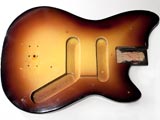
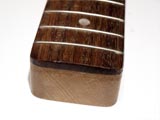
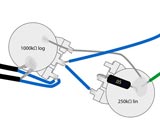
$950
£499
€555
£354
€555